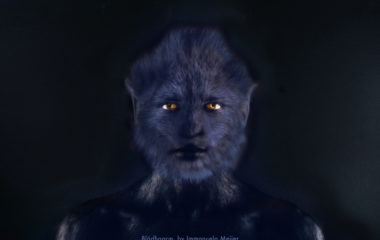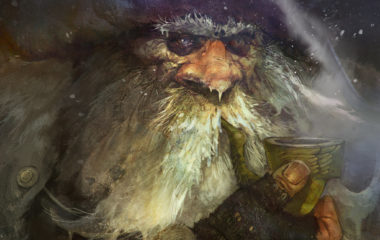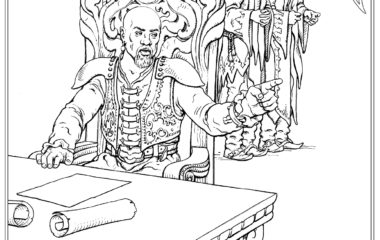Located at the base of the volcanic hollow of Farthen Dûr deep within the Beor Mountains, Tronjheim is the capital of the dwarf nation.
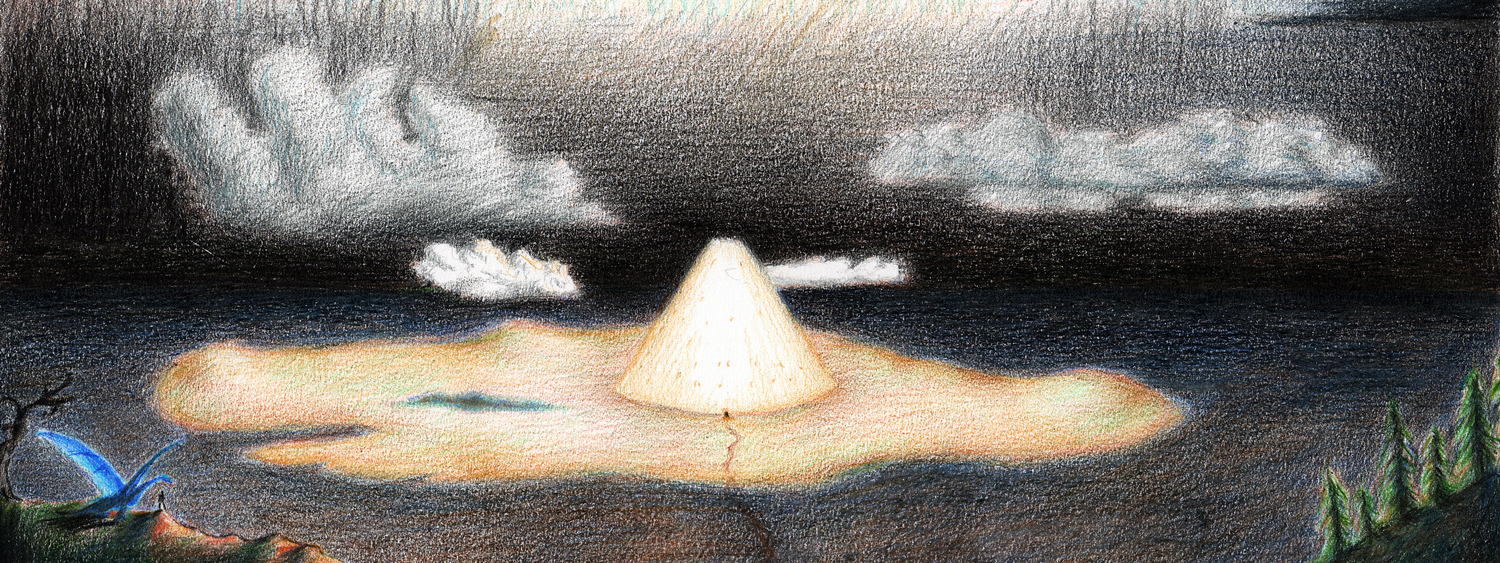
King Korgan Longbeard discovered Farthen Dûr a short time after the dwarves’ mass exodus from their homeland plains due to desertification. They built the city-mountain out of the purest marble in the following millennia, intending for it to house the entire race in times of trouble.
Architecture
Conical, Tronjheim’s diameter spans two miles and one thousand feet; it measures just over one mile from base to summit. The eastern corridor that extends from the outside wall to the interior is four stories high. Every level rings the central chamber (one thousand feet wide) with a line of open arches; the great chamber is crowned with Isidar Mithrim, an enormous star-sapphire (sixty feet in diameter) carved in the likeness of a rose. Above the Star-Rose lies the dragonhold, open to the skies. The Endless Staircase, Vol Turin, and its accompanying slide spiral from near Isidar Mithrim to the central chamber’s base; a dwarf using the slide starting from the summit of the staircase could look forward to a ten minute ride down. (Larger creatures could very well be thrown to their deaths if they attempted the same—a risk Eragon was forced to take during the Battle of Farthen Dûr). The monarch’s throne room is located just below the great chamber’s floor. Underneath the city itself, residents can visit the salt water baths, catacombs, and a large lake. Tronjheim is also home to the Drums of Derva and a vast library that may rival that of the elves.
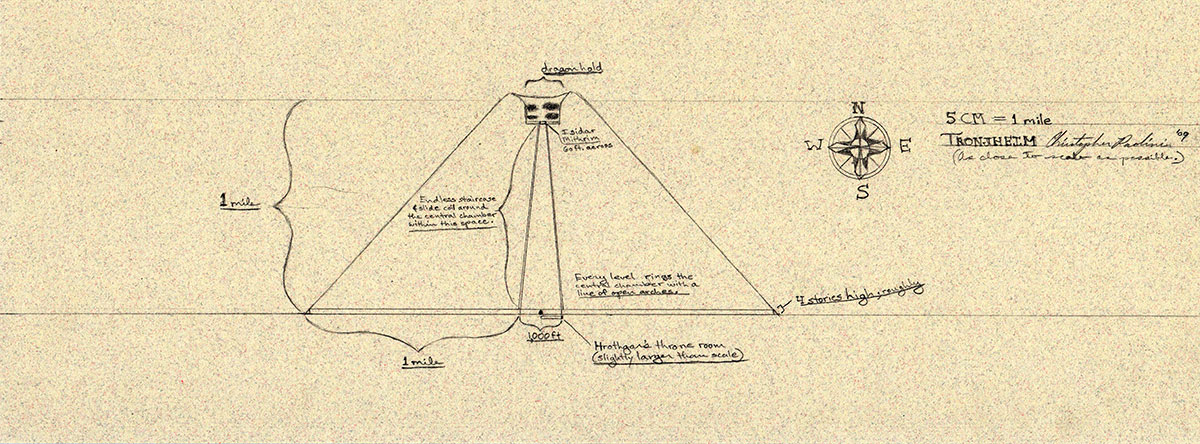
Function
The base of Farthen Dûr’s crater receives only one hour of direct sunlight during high summer. The rest of the time, the interior of the mountain is in perpetual shadow, lending Tronjheim its second name: City of Eternal Twilight. The dwarves employ countless flameless lanterns of every color within Tronjheim to counter the darkness. (They also use flashing lanterns as a means of swift communication between residents on different floors.)
Most dwarves live elsewhere in the Beor Mountains during times of peace, leaving Tronjheim largely abandoned. Due to the shadowed nature of Farthen Dûr, it is impossible to farm, and so the city relies on resources and supplies from other settlements. (And those who do venture onto the bare lands at base of the crater must exercise caution, because giant icicles occasionally fall from the upper reaches of Farthen Dûr’s over ten mile height.) Some dwarves argue to abandon the architectural wonder due to its impracticality, but the city has saved the race from extinction on three previous occasions, so it remains ever-ready for emergency use.
The golden age of the Dragon Riders came to an end with Galbatorix’s rise to power. Together with the Forsworn, he destroyed the Riders and forced the elves and dwarves into hiding. A group of human resistance fighters then formed a coalition called the Varden, which the dwarves agreed to secretly house in Tronjheim.
For nearly one hundred years things continued in this manner until the dragon Saphira hatched for Eragon and they made their way to Tronjheim to join the cause. Shortly after, Durza and his Urgal army invaded Farthen Dûr. The resistance won the battle, but Isidar Mithrim was shattered in the process. Saphira promised to make the star sapphire whole again if each shard—each speck of its dust—was perfectly assembled. The dwarves somehow accomplished this and Saphira repaired the gem to greater than its former glory.
Following Durza’s defeat, the Varden decided to wage open war against Galbatorix. Supplies were meager in the city-mountain, so they relocated to Surda and, from there, set out to conquer the Empire. The dwarves joined in, but King Hrothgar was killed on the Burning Plains, so it was necessary for them to withdraw from the front lines in order to elect a new monarch. Some time later, Orik was crowned in the city’s great chamber during a grand ceremony, and he ordered that they rejoin the battle. Following Galbatorix’s defeat, the dwarven warriors returned to the Beor Mountains and, perhaps, a few of them to their homes in Tronjheim.

Known residents:
Ajihad
Deynor
Dóndar
Elessari
Elva
Falberd
Fredric
Forna
Glûmra
Greta
Grim Halfstave
Hrothgar
Jarsha
Jörmundur
Kaga
Korgan Longbeard
Kvîstor
Nasuada
Orik
Sabrae
Skeg
Trianna
Twins, the
Umérth
Weldon
City locations/things:
Drums of Derva
Endless Staircase
Isidar Mithrim
Star-Sapphire
Vol Turin
Descriptions:
Tunnels leading to interior of Farthen Dûr:
“Now he could see thick marble pillars laced with rubies and amethysts standing in rows along the walls. Scores of lanterns hung between the pillars, suffusing the air with liquid brilliance. Gold tracery gleamed from the pillars’ bases like molten thread. Arching over the ceiling were carved raven heads, their beaks open in mid-screech. At the end of the hallway rested two colossal black doors, accented by shimmering silver lines that depicted a seven-pointed crown that spanned both sides.” (Narrative, 1st edition Eragon, page 396)
“Marble pillars studded with rubies and amethysts lined the first fifty feet of the tunnel. Past them the tunnel was bare and desolate, the smooth walls broken only by a single flameless lantern every twenty yards and at infrequent intervals by a closed gate or door.” (Narrative, 1st edition Brisingr, page 548)
Expand descriptions.
From afar:
“They were inside a massive volcanic crater. Its walls narrowed to a small ragged opening so high above that Eragon could not judge the distance—it might have been more than a dozen miles. A soft beam of light fell through the aperture, illuminating the craters center, though it left the rest of the cavernous expanse in hushed twilight.
The crater’s far side, hazy blue in the distance, looked to be nearly ten miles away. Giant icicles hundreds of feet thick and thousands of feet long hung leagues above them like glistening daggers. Eragon knew from his experience in the valley that no one, not even Saphira, could reach those lofty points. Farther down the crater’s inner walls, dark mats of moss and lichen covered the rock.
He lowered his gaze and saw a wide cobblestone path extending from the doors’ threshold. The path ran straight to the center of the crater, where it ended at the base of a snowy-white mountain that glittered like an uncut gem with thousands of colored lights. It was less than a tenth of the height of the crater that loomed over and around it, but its diminutive appearance was deceiving, for it was slightly higher than a mile.
Long as it was, the tunnel had only taken them through one side of the crater wall. As Eragon stared, he heard Orik say deeply, “Look well, human, for no Rider has set eyes upon this for nigh over a hundred years. The airy peak under which we stand is Farthen Dûr—discovered thousands of years ago by the father of our race, Korgan, while he tunneled for gold. And in the center stands our greatest achievement: Tronjheim, the city-mountain built from the purest marble.” (1st edition Eragon, pages 397-398)
Gates and interior:
“They neared the city-mountain, and Eragon saw that the white marble of Tronjheim was highly polished and shaped into flowing contours, as if it had been poured into place. It was dotted with countless round windows framed by elaborate carvings. A colored lantern hung in each window, casting a soft glow on the surrounding rock. No turrets or smokestacks were visible. Directly ahead, two thirty-foot-high gold griffins guarded a massive timber gate—recessed twenty yards into the base of Tronjheim—which was shadowed by thick trusses that supported an arched vault far overhead.
When they reached Tronjheim’s base, Saphira paused to see if the bald man had any instructions. When none were forthcoming, she continued to the gate. The walls were lined with fluted pillars of blood-red jasper. Between the pillars hulked statues of outlandish creatures, captured forever by the sculptor’s chisel.
The heavy gate rumbled open before them as hidden chains slowly raised the mammoth beams. A four-story-high passageway extended straight toward the center of Tronjheim. The top three levels were pierced by rows of archways that revealed gray tunnels curving off into the distance. Clumps of people filled the arches, eagerly watching Eragon and Saphira. On ground level, however, the archways were barred by stout doors. Rich tapestries hung between the different levels, embroidered with heroic figures and tumultuous battle scenes.” (Narrative, 1st edition Eragon, pages 399-400)
“The mile-long hall ended in an arch flanked by black onyx pillars. Yellow zircons three times the size of a man capped the dark columns, coruscating piercing gold beams along the hall. Saphira stepped through the opening, then stopped and craned back her neck, humming deeply in her chest.
They were in a circular room, perhaps a thousand feet across, that reached up to Tronjheim’s peak a mile overhead, narrowing as it rose. The walls were lined with arches—one row for each level of the city-mountain—and the floor was made of polished carnelian, upon which was etched a hammer girdled by twelve silver pentacles, like on Orik’s helm.
The room was a nexus for four hallways—including the one they had just exited—that divided Tronjheim into quarters. The halls were identical except for the one opposite Eragon. To the right and left of that hall were tall arches that opened to descending stairs, which mirrored each other as they curved underground.
The ceiling was capped by a dawn-red star sapphire of monstrous size. The jewel was twenty yards across and nearly as thick. Its face had been carved to resemble a rose in full bloom, and so skilled was the craftsmanship, the flower almost seemed to be real. A wide belt of lanterns wrapped around the edge of the sapphire, which cast striated bands of blushing light over everything below. The flashing rays of the star within the gem made it appear as if a giant eye gazed down at them.
Eragon could only gape with wonder. Nothing had prepared him for this. It seemed impossible that Tronjheim had been built by mortal beings. The city-mountain shamed everything he had seen in the Empire. He doubted if even Urû’baen could match the wealth and grandeur displayed here. Tronjheim was a stunning monument to the dwarves’ power and perseverance.” (Narrative, 1st edition Eragon, pages 400-401)
“Only a scant amount of daylight filtered down to the base of Tronjheim. The City of Eternal Twilight, the elves called it. Since so little of the sun’s radiance entered the city-mountain—except for a dazzling half hour before and after noon during the height of summer—the dwarves illuminated the interior with uncounted numbers of their flameless lanterns. Thousands of them were on glorious display in the chamber. A bright lantern hung from the outside of every other pillar of the curved arcades that lined each level of the city-mountain, and even more lanterns were mounted within the arcades, marking the entrances to strange and unknown rooms, as well as the path of Vol Turin, the Endless Staircase, which spiraled around the chamber from top to bottom. The effect was both moody and spectacular. The lanterns were of many different colors, making it appear as if the interior of the chamber were dotted with glowing jewels.” (Narrative, 1st edition Brisingr, page 439)
“He stood in an open arcade that curved gently to the left and encircled Tronjheim’s central chamber. Between the slender columns supporting the arches, Eragon could see Isidar Mithrim sparkling brilliantly above him, as well as the city-mountain’s distant base. The circumference of the central chamber increased with each successive level. The staircase cut through the arcade’s floor to an identical level below and descended through scores of arcades until it disappeared in the distance. The sliding trough ran along the outside curve of the stairs. At the top of Vol Turin was a pile of leather squares to slide on. To Eragon’s right, a dusty corridor led to that level’s rooms and apartments.” (Narrative, 1st edition Eragon, page 434)
Catacombs:
“Through many caverns they marched, passing stone huts where dwarven children clutched their mothers and stared with wide eyes.
Boom.
And with that final crescendo, they halted under ribbed stalactites that branched over a great catacomb lined with alcoves. In each alcove lay a tomb carved with a name and clan crest. Thousands—hundreds of thousands—were buried here. The only light came from sparsely placed red lanterns, pale in the shadows.” (Narrative, 1st edition Eldest, page 57)
Dragonhold:
“Out of these halls so Saphira can fly to the dragonhold above Isidar Mithrim, the Star Rose. The dragonhold doesn’t have a roof—Tronjheim’s peak is open to the sky, like that of Farthen Dûr—so she, that is, you, Saphira, will be able to glide straight down into the hold. It is where the Riders used to stay when they visited Tronjheim.”
“Won’t it be cold and damp without a roof?” asked Eragon.
“Nay.” Orik shook his head. “Farthen Dûr protects us from the elements. Neither rain nor snow intrude here. Besides, the hold’s walls are lined with marble caves for dragons. They provide all the shelter necessary. All you need fear are the icicles; when they fall they’ve been known to cleave a horse in two.”(1st edition Eragon, page 421)
“They were above Tronjheim now. Eragon looked down through the opening in its peak and saw the floor of the dragonhold: Isidar Mithrim, the great star sapphire. He knew that beneath it was nothing but Tronjheim’s great central chamber. Saphira descended to the dragonhold on silent wings. She slipped over its rim and dropped to Isidar Mithrim, landing with the sharp clack of claws.
Won’t you scratch it? asked Eragon.
I think not. It’s no ordinary gem. Eragon slid off her back and slowly turned in a circle, absorbing the unusual sight. They were in a round roofless room sixty feet high and sixty feet across. The walls were lined with the dark openings of caves, which differed in size from grottoes no larger than a man to a gaping cavern larger than a house. Shiny rungs were set into the marble walls so that people could reach the highest caves. An enormous archway led out of the dragonhold.” (1st edition Eragon, pages 430-431)
“She turned and, without opening her wings, jumped twenty feet into the air, landing in a medium-sized cave. He clambered up after her.
The cave was dark brown on the inside and deeper than he had expected. The roughly chiseled walls gave the impression of a natural formation. Near the far wall was a thick cushion large enough for Saphira to curl up on. Beside it was a bed built into the side of the wall. The cave was lit by a single red lantern equipped with a shutter so its glow could be muted.” (Narrative, 1st edition Eragon, page 431)
Lake:
“Hundreds of feet below Tronjheim, the stone opened up into a cavern thousands of feet long with a still black lake of unknown depth along one side and a marble shore on the other. Brown and ivory stalactites dripped from the ceiling, while stalagmites stabbed upward from the ground, and in places the two joined to form bulging pillars thicker around than even the largest trees in Du Weldenvarden. Scattered among the pillars were mounds of compost studded with mushrooms, as well as three-and-twenty low stone huts. A flameless lantern glowed iron red next to each of their doors. Beyond the reach of the lanterns, shadows abounded.” (Narrative, 1st edition Brisingr, page 472)
Library:
“The room reminded him of a forest. Rows of graceful colonnades branched up to the dark, ribbed ceiling five stories above. Between the pillars, black-marble bookcases stood back to back. Racks of scrolls covered the walls, interspersed with narrow walkways reached by three twisting staircases. Placed at regular intervals around the walls were pairs of facing stone benches. Between them were small tables whose bases flowed seamlessly into the floor.
Countless books and scrolls were stored in the room. “This is the true legacy of our race,” said Orik. “Here reside the writings of our greatest kings and scholars, from antiquity to the present. Also recorded are the songs and stories composed by our artisans. This library may be our most precious possession. It isn’t all our work, though—there are human writings here as well. Yours is a short-lived—but prolific—race. We have little or nothing of the elves’. They guard their secrets jealously.” (1st edition Eragon, page 446)
Salt Baths:
“He took Eragon down a long staircase until they were well below Tronjheim. The corridors were tunnels now—which cramped Eragon because they were only five feet high—and all the lanterns were red. “So the light doesn’t blind you when you leave or enter a dark cavern,” explained Orik.
They entered a bare room with a small door on the far side. Orik pointed. “The pools are through there, along with brushes and soap.” (Narrative, 1st edition Eragon, page 426)
“The pool was mildly salty, but soothing and calm. For a moment he was afraid of drifting away from the door, into deeper water, but as he waded forward, he discovered the water reached only to his waist. He groped over a slippery wall until he found the soap and brushes, then scrubbed himself. Afterward he floated with his eyes closed, enjoying the warmth.” (Narrative, 1st edition Eragon, page 427)
Throne room:
“A dark hall lay before them, a good bowshot long. The throne room was a natural cave; the walls were lined with stalagmites and stalactites, each thicker than a man. Sparsely hung lanterns cast a moody light. The brown floor was smooth and polished. At the far end of the hall was a black throne with a motionless figure upon it.” (Narrative, 1st edition Eragon, page 440)
“Their footsteps echoed through the hall as they advanced toward the throne. In the recesses between the stalagmites and stalactites rested large statues. Each sculpture depicted a dwarf king crowned and sitting on a throne; their sightless eyes gazed sternly into the distance, their lined faces set in fierce expressions. A name was chiseled in runes beneath each set of feet.
Eragon and Saphira strode solemnly between the two rows of long-dead monarchs. They passed more than forty statues, then only dark and empty alcoves awaiting future kings. They stopped before Hrothgar at the end of the hall.
The dwarf king himself sat like a statue upon a raised throne carved from a single piece of black marble. It was blocky, unadorned, and cut with unyielding precision. Strength emanated from the throne, strength that harked back to ancient times when dwarves had ruled in Alagaësia without opposition from elves or humans.” (Narrative, 1st edition Eragon, pages 440-441)
Like this article? Check out the rest of the Encyclopedia Alagaësia series!


